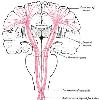

optimized with optipng Tags: Cerebral Palsy View |
Topics: Health Tags: Cerebral Palsy View |
Topics: Health Tags: Cerebral Palsy View |
|||||||||
Cerebral palsy (CP) is an umbrella term encompassing a group of non-progressive (non-progressive illness), non-contagious (Infectious diseases) motor conditions that cause physical disability in human development (Human development (biology)), chiefly in the various areas of body movement.
Cerebral refers to the cerebrum, which is the affected area of the brain (although the disorder most likely involves connections between the cortex (Cerebral cortex) and other parts of the brain such as the cerebellum), and palsy refers to disorder of movement. Cerebral palsy is caused by damage to the motor control centers of the developing brain and can occur during pregnancy, during childbirth or after birth up to about age three.
Cerebral palsy describes a group of permanent disorders of the development of movement and posture, causing activity limitation, that are attributed to nonprogressive disturbances that occurred in the developing fetal or infant brain. The motor disorders of cerebral palsy are often accompanied by disturbances of sensation, perception, cognition, communication, and behaviour, by epilepsy, and by secondary musculoskeletal problems.
Of the many types and subtypes of CP, none of them have a known cure. Usually, medical intervention is limited to the treatment and prevention of complications arising from CPs effects.
A 2003 study put the economic cost for people with CP in the US at $921,000 per individual, including lost income.
In another study, the incidence in six countries surveyed was 2.12–2.45 per 1,000 live births, indicating a slight rise in recent years. Improvements in neonatal nursing have helped reduce the number of babies who develop cerebral palsy, but the survival of babies with very low birth weights has increased, and these babies are more likely to have cerebral palsy.
Diseasesdb: 2232
Icd10: ICD10G80g80
Icd9: ICD9343
Omim: 603513
Omim Mult: OMIM2605388
Emedicinesubj: neuro
Emedicinetopic: 533
Emedicine Mult: eMedicine2pmr24
Meshid: D002547



